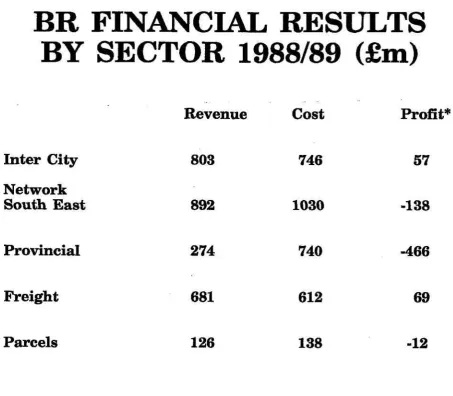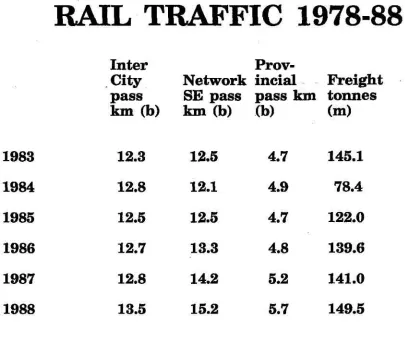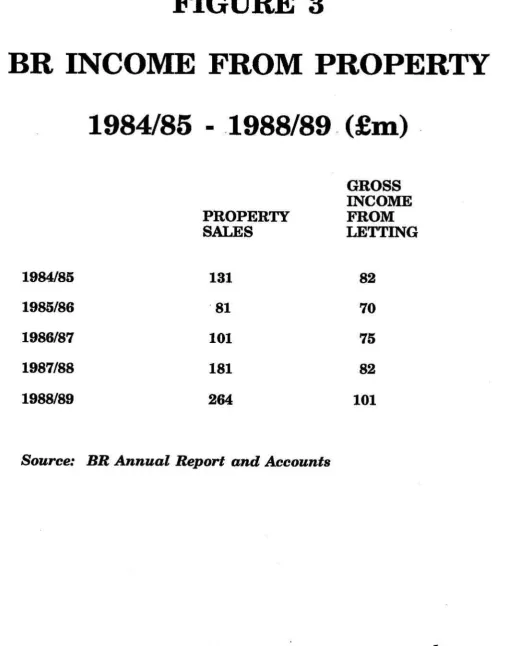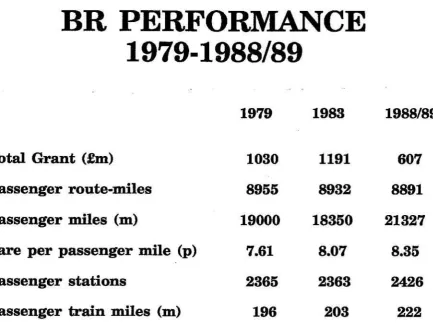This is a repository copy of Rail Privatisation: Financial Implications.
White Rose Research Online URL for this paper: http://eprints.whiterose.ac.uk/2265/
Monograph:
Nash, C.A. (1990) Rail Privatisation: Financial Implications. Working Paper. Institute of Transport Studies, University of Leeds , Leeds, UK.
Working Paper 294
eprints@whiterose.ac.uk https://eprints.whiterose.ac.uk/
Reuse See Attached
Takedown
If you consider content in White Rose Research Online to be in breach of UK law, please notify us by
White Rose Research Online
http://eprints.whiterose.ac.uk/
Institute of Transport Studies University of Leeds
This is an ITS Working Paper produced and published by the University of Leeds. ITS Working Papers are intended to provide information and encourage discussion on a topic in advance of formal publication. They represent only the views of the authors, and do not necessarily reflect the views or approval of the sponsors.
White Rose Repository URL for this paper: http://eprints.whiterose.ac.uk/2265/
Published paper
Nash, C.A. (1990) Rail Privatisation: Financial Implications. Institute of Transport Studies, University of Leeds. Working Paper 294
Working
Paper
294
May
1990
RAIL PRIVATISATION:
FINANCIAL IMPLICATIONS
Chris Nash
ITS Working Papers are intended to provide information and encourage discussion on a topic in advance of formal publication. They represent only the views of the authors, and do not necessarily refict the views or approval of the sponsors.
My aim in this brief paper is not to argue the case for or against privatisation, but rather to comment on the likely financial implications of some of the options. Nevertheless, it does not seem possible to do this without briefly reviewing the advantages and disadvantages that are claimed to flow h m privatisation. I will then consider the existing organisation and financial performance of British Rail. Following this, I will discuss alternative ways of achieving the necessary level of profitability for private investors to be interested in owning and operating the railway system.
2. FOR
AND
AGAINST PRIVATIATIONThe case in favour of privatisation is usually cast in terms of greater incentives both to innovate and provide better services, and to reduce operating costs through increased efficiency. I believe there is little argument that these incentives are strongest where the private company concerned is free of external regulation, but faces intense competition in the markets in which it is producing and selling. Nevertheless, competition in the capital market provides incentives to maximise profits even where competition in the product market is less strong. However, profit maximisation in this case may take the form of pricing up and reducing quality of service. Government may then intervene with controls on prices and service quality. But such controls are not easy to enforce, whilst if there is any indication that price rises will automatically be permitted to allow the company a reasonable rate of r e t m then the incentive to efficient operation is weakened. Whilst in the short term, regulation of the RP1 minus X variety (ie allowing price increases a t the rate
of inflation less an allowance for anticipated productivity increases) may reduce this risk, it has been argued that in the long term
-
given the need to ensure that the company earns enough to be able to invest and stay in business-
such a system of regulation almost inevitably reverts to rate of return regulation.Arguments against privatisation may be grouped into two categories. Firstly arguments against private ownership per se are usually couched i n terms of the social obligations of the railway. The question here is whether such social obligations are desirable, and if they are, whether they can be adequately and efficiently provided for by contractual arrangements with private operators or by regulation. Secondly come arguments regarding the appropriate organisation of railway activities. If the advantages of privatisation require competition, and yet any organisation which provides for competition loses economies of scale and benefits of integration of the services of the various companies, then it is argued that the supposed benefits of privatisation are illusory, or could only be achieved at
an unacceptable cost in other reap&.
3. CURRENT BR ORGANISATION
Let me now consider the question of organisation in more detail. British Rail is currently divided into five sectors
-
Inter City, Network Southeast and Provincial being the passenger sectors, with Freight and Parcels as non-passenger (there is a sixth sector, European passenger services, but it does not yet have any revenue). However, sector (and within those subsector) managers are only responsible for the planning and marketing of services within their control. The actual operation of the services is undertaken by a separate operations function, which is divided geographically on a region and area basis. The relationship between sectors and operations is essentially a contractual one, although with the sectors being requiredto
negotiatewith
a
monopoly supplier. Efficient operation of services relies on thepressure of financial targets and constraints rather than the force of competition between suppliers.
It
is well known that BR is currently hrther reviewing its organisation, with a view to decentralising operations on a sector, rather than a regional basis. Under such an organisation, the sectors would effectively become separate companies each with their own infrastructure, stations, rolling stock and operating staff. In other words, the trend of recent years of allocating staff and assets more clearly to individual sectors and subsectors would be taken to its ultimate conclusion.Such a change is widely seen as paving the way for privatisation on a sector by sector basis, and indeed it now seems almost certain
that
if privatisation goes aheadthat will be the form it will take (perhaps with Provincial being split into a number of geographically based companies). In what follows, I will concentrate on the financial implications of this form of privatisation. In terms of the above discussion, however, it should be noted that a sector by sector privatisation is not likely to lead to a large amount of competition within the railway industry (only the infrastructure plus operating companies option would be likely to achieve that) and that some loss of economies of scale through the various sectors needing to develop their own facilities in the same locations is possible. The latter will only happen, however, if sensible contracts for one sector to provide facilities or services for another cannot be worked out.
It is this issue that leads to the greatest complexities i n considering how a system of separately privatised sectors would work. For the sectors do remain interdependent to a considerable degree. Take, for instance, the city I come from, Leeds.
The station is deemed to be a Provincial station, because the majority of trains and passengers using it belong to that sector. Inter City currently pays the avoidable cost of its trains using the station
-
that is for any extra staff or facilities which would be avoided if Inter City ceased to operate from Leeds. But if Provincial were a separate privately owned company, presumablyit
would have an incentive to put up its charges to Inter City for the use of Leeds station until either it had creamed off all the profits Inter City makes in Leeds, or had put the charges so high that Inter City was considering building its own separate station.On the other hand, the main line into Leeds from Doncaster, which carries the service from London, currently belongs to Inter City. Provincial runs local services over the route, which is also used by Freight and Parcels trains, all on an avoidable cost basis. In this case, Inter City would have an incentive to cream off all the profits the other sectors were able to make (in the case of local services, judging the maximum the
PTE
would be willing to pay before removing its support for them).The situation described in this example
is
not peculiar to West Yorkshire; it would be replicatedall
over the country. In other words, what would be created bya
sector by sector privatisation is a whole series of local monopoly situations, each one of which would lead to complex bargaining. In its proposed reorganisation, BR seems to be relying on a "balance of power" between the sectors to ensure that sensible deals are struck, plus the threat of intervention from the central "holding company" if that proved inadequate. In a privatised situation, it seems likely that a regulatory body would be needed to police the provision of access to monopolised facilities, as well as to ensure compatible and adequate technical and safety standards.
I
think that this example serves to show some of the regulatory complexities. What,-
then, of the financial attractiveness of BR to private investors. This rests on 'three issues: profitability of rail services themselves, prospects for property development and availability of subsidies.
4. IMPROVING SECTOR FINANCIAL PERFORMANCE
What are the prospects of improving the financial performance of the sectors sufficiently to attract private investors? Much depends on the degree to which the change of ownership itself leads to innovations wbich reduce costs or raise revenue, and the following discussion reflects my view that, in the absence of effective competition within the industry, that will not be a major factor.
Of the five sectors, none yet earns what might be regarded as a fully commercial return on its assets, although Inter City and Freight
both
showed a profit last year (Figure 1). Network Southeast has the target of operating without subsidy by 1992193, whilst for Provincial as a whole any thought of operation without subsidy is inconceivable. In the long term, it is intended that the commercial sectors should earn at least the standard public sector 8% real rate of return on all their assets, including infrastructure and property holdings. Even this would probably not be an attractive rate of return for a private investor.The market for rail passenger services has been buoyant in the last few years (Figure 2), although it is very sensitive to the state of the economy and is already being affected by the slowdown in consumer spending. In the case of Inter City, the mean price elasticity of demand appears to be about 1.2, indicating that a general rise in real fares does not add to revenue, and only makes sense as a way of constraining growth in demand (especially a t peaks) in order to avoid costs. Demand is also very sensitive to the quality of service, and the current Inter City strategy is to increase demand by further quality improvements, taking the benefits partly in increased volumes and partly in increased fares. There seems no particular reason
to
expect this strategy to change dramatically if the business were privatised, although there may be a greater tendency to concentrate on the 'core' services a t the expense of the peripheral ones.The position of Network Southeast is rather different. Two thirds of its traffic consists of London commuters, who represent something of
a
captive market. Although some studies have suggested that NSE t d c is more price and quality sensitive than is often thought, especially in the longer run when the location decisions of new entrants to the commuting market may be influenced, there is little doubt that this sector could be made more profitable by carrying a reduced volume at much higher fares. This would also have the attraction of removing the need for expensive measures to expand the capacity of the rail infrastructure in the London are. Whether deliberate measures to reduce rail commuting into London would be seen as socially desirable, involving as they must some combination of increasing road traffic and reduction in the number of jobs in Central London, seems more questionable. In this sector, price and service quality regulation is almost certain to be necessary, whilst the possibility of continuing subsidies andlor capital grants cannot be ruled out. If the government persists in its plans to make this sector commercially viable, of course many of the same changes willtake
place even in public ownership.The Provincial sector contains the biggest variety of types of rail service of any of the passenger sectors, ranging from moderately profitable interurban and cross country services, through urban commuter services to highly unprofitable rural ones. Although its costs have been greatly reduced by the introduction of modern diesel multiple units in recent years
-
a process which is not yet complete-
and there may-
-
remain some scope for improving profitability by reducing costs and increashg 'fares, the principal issue in this sector is the future level and form of subsidies.
Within the freight and parcels sectors, the principal financial problems surround the non-bulk freight operations run by Railfreight Distribution. The opening of the Channel Tunnel, offering the sort of lengths of haul at which such services can be profitable, can be expected to relieve these problems, and the organisation is likely to concentrate increasingly on long haul European intermodal and deepsea container operation, with domestic traffic only being carried where
it
is sensibly complementary to these markets.5. PROPERTY DEVELOPMENT
Despite the large scale sales of recent years, British Rail still owns a great deal of property, operational and non-operational, as indicated by the level of the gross income h m letting (Figure 3). One of the first suggestions that British Rail might
be a candidate for privatisation
-
from Beesley and Littlechild in 1983-
saw the prospect of privatisation as resting entirely on the value of the property assets, with any train services remaining after privatisation being provided as a result of a continuing public service obligation.Certainly the property holdings of BR could prove attractive to developers, although any obligation to continue to run train services would tend to decrease that attraction. Even within the profitable sectors of BR, we have seen that running rail services is not likely to earn profits comparable to those to be made &om property development. Thus where the two aims conflict,
it
is likely to be the rail service that suffers. 'Whilst it may be true that in some cases-
particularly in London-
development of rail services and of property may be seen as complementary (as in Japan, where private rail companies have combined the two successfully for many years), elsewhere in the country, where rail is not likely to be seen asan
important mode of transport to new developments, there is less chance of this happening. The case of privatised bus companies, which have shown considerable haste to convert their property holdings to more protitable uses than running buses, is a good example. Overall, whether relying on a reluctant property company to provide a rail service yields a good quality service seems doubtful.6. SUBSIDY
In recent years, British Rail has experienced an enormous reduction in subsidies, without any major reductions in services
-
indeed passenger train miles have gone up (Figure 4). Nevertheless, it seems clear that if anything like the existing pattern of local rail services is to survive, then there will be a continued need for subsidy. Given the reluctance of both local and central government to see large scale rail closures, it therefore seems important to ensure that any new arrangements arecompatible with the efficient administration of subsidies.
For
a private company to take wer the Provincial sector-
or a large part of it-
without some assurance of the level and duration of subsidies for it would seem to be a risky business. On the other hand, if governments really are so reluctant to see rail closures, then ownership of the infrastructure on which rail services are run could again confer a very real degree of monopoly. Perhaps protection for both parties
-
a t least temporarily - could be obtained by the negotiation of a long term contract at the time of privatisation. But this seems incompatible with what surely must be another sensible objective-
to decentralise the administration of subsidies to make it more clear exactly what services the government is buying a t what price, perhaps with greater local government involvement. It is also not clear what-
-
protection is afforded in the longer term.
It is with respect to local services that competitive tendering may have a role to play. Indeed competitive tendering for the contract to run train services on a particular route already exists on a small scale in
a
number of countries. In Sweden, which has already gone down the path of separation of i&astructure from operations,it
is understood that a bus company has won the contract for operation of the local train service in one area. But this is in the context of continued government ownership both of the infrastructure and rolling stock, the latter being leased to the operating company. It may be that some such arrangement, with continued government ownership of the assets, is the only way in which privatisation of the Provincial sector would be a practical proposition.7
.
CONCLUSIONS
Of the various privatisation models for BR, the one that seems most likely to be implemented is privatisation on a sector by sector basis. However, we have seen that this is by no means a simple matter. The sectaw remain very interdependent, and complex negotiations in which each sector possesses considerable monopoly power in particular circumstances will be needed to determine the hancial relationships between them. Whether one can rely on a balance of monopoly power to lead to socially desirable outcomes seems quite doubtful, so it would seem that these negotiations would need to be subject to regulation to ensure reasonable access
to the idi-astructure for each sector at an appropriate price. In any case regulation of technical and safety standards would continue to be necessary.



